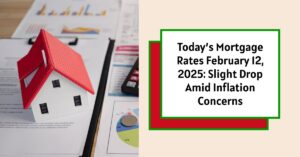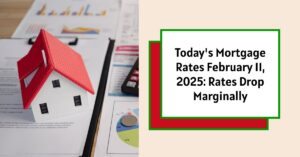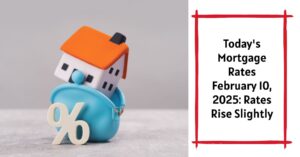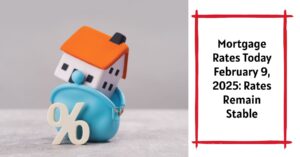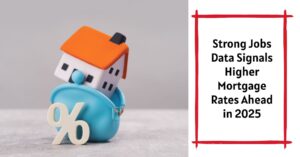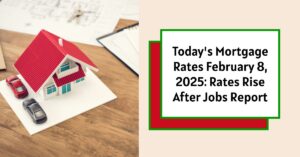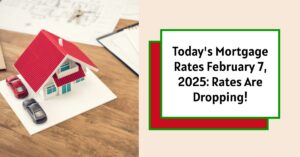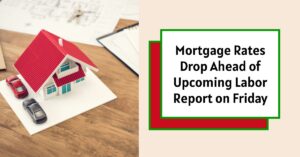As of February 12, 2025, the average mortgage rates reflect a decline, albeit small, amidst ongoing concerns about persistent inflation. The average for a 30-year fixed mortgage is 6.91%, down by 0.05% from the previous week, while a 15-year fixed mortgage stands at 6.23%, experiencing a decrease of 0.02%. Understanding the current trends in mortgage rates is crucial for home buyers and those contemplating refinancing, as rates can drastically influence overall borrowing costs and financial planning.
Today’s Mortgage Rates February 12, 2025: Rates Drop Slightly Amid Inflation Concerns
Key Takeaways
- Average Mortgage Rates:
- 30-year fixed: 6.91%
- 15-year fixed: 6.23%
- 30-year fixed jumbo: 6.95%
- 5/1 ARM: 6.12%
- Rate Changes:
- Slight declines indicate minor improvements for potential borrowers.
- Federal Reserve Influence:
- The Fed's hold on cuts means borrowers may face continued high rates until significant economic shifts occur.
Today's Average Mortgage Rates
Here’s a quick snapshot of the current mortgage rates as of February 12, 2025, which have shown minor fluctuations over the past week:
| Mortgage Type | Current Rate | Change |
|---|---|---|
| 30-Year Fixed Rate | 6.91% | (-0.05%) |
| 15-Year Fixed Rate | 6.23% | (-0.02%) |
| 30-Year Fixed Rate Jumbo | 6.95% | (-0.03%) |
| 5/1 Adjustable Rate Mortgage (ARM) | 6.12% | (-0.03%) |
| 10-Year Fixed Rate | 6.11% | (+0.04%) |
These figures are derived from the latest data reported by Bankrate, reflecting offers from lenders across the U.S. This table provides potential home buyers with a clear view of current borrowing costs, enabling informed decision-making.
Understanding What’s Driving Mortgage Rates
The current economic climate significantly impacts mortgage rates. Since reaching historic lows below 3% during the pandemic, rates have fluctuated due to various economic factors, primarily inflation. High inflation typically leads to higher borrowing costs, which is evident in the current environment. Economists speculate that as inflation persists, it creates conditions that can sustain elevated rates, making it increasingly difficult for prospective homeowners.
Interestingly, the Federal Reserve’s decision to pause interest rate cuts highlights their cautious approach in the face of an uncertain economic forecast. The Fed reacts to changing economic data, and while it has briefly reduced rates in 2024, it is unlikely to pursue further cuts until there is significant evidence of moderate inflation. This means that borrowers might find themselves navigating a challenging landscape if they seek to finance or refinance a home.
Where Are Mortgage Rates Headed?
Forecasting mortgage rates can be tricky due to the myriad factors at play, including economic indicators, government policies, and market trends. According to forecasts, 30-year fixed mortgage rates could stabilize between 6% and 7% for most of 2025. Specifically, some analysts forecast a gradual decrease towards 6.4% by the year’s end. However, these rates are still significantly higher than the more favorable ones seen in previous years.
Additionally, experts warn that despite any potential decrease, mortgage rates remain high compared to historical norms, and affordability will continue to be an issue for many buyers. Higher home prices combined with elevated mortgage rates create a double-edged sword that complicates the home buying process.
The Different Types of Mortgages Available
When exploring mortgage options, it’s essential to understand the varieties available to choose the one that aligns with your financial situation and goals.
1. 30-Year Fixed-Rate Mortgage
This is often the go-to option for homebuyers, offering a predictable monthly payment over a lengthy term. With an average rate of 6.91%**, borrowers can budget effectively, knowing what their payment will be for the life of the loan. While the longer term leads to less pressure on monthly budgets, it also results in more interest being paid over time.
2. 15-Year Fixed-Rate Mortgage
For those who wish to pay off their home sooner and save on interest, the 15-year fixed mortgage at 6.23%** is an appealing choice. The payment will be higher than on a 30-year mortgage, but the total interest paid over the life of the loan is significantly lower, which can be a strong incentive for many homeowners.
3. Adjustable-Rate Mortgages (ARMs)
The 5/1 ARM, with an average rate of 6.12%**, offers a lower fixed rate for the initial five years before adjusting annually based on the market. This can benefit borrowers planning to sell or refinance within that period, as they enjoy lower rates during the initial fixed period. However, buyers must be cautious of potential rate hikes after the introductory period, which could significantly increase monthly payments.
Recommended Read:
Mortgage Rates Trends on February 11, 2025
Mortgage Rate Predictions for February 2025: Will Rates Drop?
Mortgage Interest Rates Forecast for Next 10 Years
Interest Rate Forecast for Next 10 Years: 2025-2035
Mortgage Rates Expected to Rise Further Due to Strong Jobs Data
Detailed Monthly Payment Calculations
Understanding your monthly mortgage payment is crucial for effective budgeting. Utilizing the current average rates, here are estimates for different loan amounts:
Monthly Payment on a $150,000 Mortgage
At an average rate of 6.91% for a 30-year fixed mortgage:
- Approximate Monthly Payment: $1,014.02
Monthly Payment on a $200,000 Mortgage
For a $200,000 mortgage at 6.91%:
- Approximate Monthly Payment: $1,352.02
Monthly Payment on a $300,000 Mortgage
If you take on a $300,000 mortgage:
- Approximate Monthly Payment: $2,028.03
Monthly Payment on a $400,000 Mortgage
A loan amount of $400,000 would bring the monthly payment to:
- Approximate Monthly Payment: $2,704.03
Monthly Payment on a $500,000 Mortgage
For those needing a $500,000 mortgage:
- Approximate Monthly Payment: $3,380.04
These calculations illustrate how significantly loan amounts and interest rates influence your monthly financial commitments, making it essential to choose the right mortgage type for your budget.
The Role of Credit Scores and Down Payments
When considering a mortgage, your credit score and down payment play vital roles in securing favorable rates. Credit scores typically range from 300 to 850, and most lenders look for a score of 620 or higher. However, a higher score can lead to better rates. Aim for a score of at least 740 for the best possible terms.
Down payments can also significantly affect your mortgage offer. While it's common to see loans that require only 3% to 5% down, a 20% down payment can help you avoid Private Mortgage Insurance (PMI) and will lower your monthly payment as you're borrowing less. Saving for a larger down payment is always a smart strategy in any market.
Understanding the Fine Print of Your Mortgage
Once you've chosen your mortgage, it's important to understand the terms. Every loan comes with different conditions, and understanding the details will help prevent any surprises.
- Fixed vs. Adjustable Rates: Fixed rates offer consistency and predictability, while adjustable rates can fluctuate and potentially increase your monthly payment significantly after an introductory period.
- Closing Costs: These are additional fees associated with finalizing your mortgage and can range from 2% to 5% of the loan amount. Ensure you account for these costs in your budget.
- Early Repayment Penalties: Some loans may have penalties if you pay off your mortgage early. Always check whether this applies to your loan.
Final Thoughts on Today's Mortgage Landscape
Navigating the mortgage landscape requires attention to current rates and economic conditions. While the recent changes in rates offer slight relief for homebuyers, the bigger picture emphasizes that high costs are still prevalent.
As inflation persists and interest rates remain volatile, the housing market continues to become increasingly complex. Prospective homeowners should stay informed, prepare a comprehensive budget, and seek expert advice to ensure they select the best mortgage option tailored to their needs.
Work with Norada in 2025, Your Trusted Source for
Real Estate Investing
With mortgage rates fluctuating, investing in turnkey real estate
can help you secure consistent returns.
Expand your portfolio confidently, even in a shifting interest rate environment.
Speak with our expert investment counselors (No Obligation):
(800) 611-3060
Recommended Read:
- Mortgage Rates Forecast for the Next 3 Years: 2025 to 2027
- 30-Year Mortgage Rate Forecast for the Next 5 Years
- 15-Year Mortgage Rate Forecast for the Next 5 Years
- Why Are Mortgage Rates Going Up in 2025: Will Rates Drop?
- Why Are Mortgage Rates So High and Predictions for 2025
- NAR Predicts 6% Mortgage Rates in 2025 Will Boost Housing Market
- Mortgage Rates Predictions for 2025: Expert Forecast
- Will Mortgage Rates Ever Be 3% Again: Future Outlook
- Mortgage Rates Predictions for Next 2 Years
- Mortgage Rate Predictions for Next 5 Years
- Mortgage Rate Predictions for 2025: Expert Forecast
- Mortgage Rate Predictions: Why 2% and 3% Rates are Out of Reach
- How Lower Mortgage Rates Can Save You Thousands?
- How to Get a Low Mortgage Interest Rate?
- Will Mortgage Rates Ever Be 4% Again?
